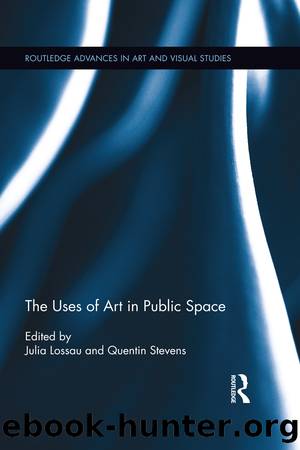The Uses of Art in Public Space by Julia Lossau Quentin Stevens

Author:Julia Lossau, Quentin Stevens [Julia Lossau, Quentin Stevens]
Language: eng
Format: epub
ISBN: 9781138797604
Barnesnoble:
Publisher: Taylor & Francis
Published: 2014-12-16T00:00:00+00:00
Audio Walks and Sound Art
Interest in audio walks has grown in recent years as different groups recognise the formâs potential for revealing and forging place in different ways. In essence, audio walks are audio guided routes through place. Sometimes they can take form through the provision of quite factual information, and at others they can proffer new worlds and experiences for the participants. They can be accompanied by a map, or not, and they can be narrated by single individuals or multiple voices and characters. As an art form, audio walks emerged from a disgruntlement with the visual predominance and institutional traditions of the art world (Butler 2006); they were a means of moving beyond and outside the gallery and the concert hall, they emphasised art as something mobile not situated, and they drew attention to art as an everyday, relational forging rather than an absolute object. Not all audio walks are art, although they are all processes of creation and construction. The content and nature of the walk places it somewhere along a spectrum of art to information, which can be negotiated by the place, time and participant as well, perhaps, as the intention of the constructor. In more recent years audio walks have been appropriated for more touristic ends, for they are seen to offer a powerful way of introducing people to, and taking them through, the historical, cultural and social landscapes of towns and cities (Footnotes 2009). They provide not only an opportunity to share social knowledges and heighten spatial literacy, but they can convey an insiderâs view of place that reveals its difference, its quirkier and grittier side through the multilayering of media and the construction of multiple realities in each meander. Consequently, audio walks give the impression of offering a city experience that is off-the-beaten-track and therefore more in-depth and engaged with the social and physical worlds they traverse.
One result of this commercial and touristic exploitation is that we have become accustomed to understand audio walks through very established conventions: They present place as a series of interesting sites; they are linear and coherent in nature; they identify aspects of place that need to be discovered and made visible; they reduce the complexity of place to a singular narrative and they narrate it by pausing its flow and eddy. Audio walks, therefore, seemingly code the spatial imaginaries and aesthetic experiences of their creators and consumers in particular ways. They pivot on and create what Ingold (2005) might term point-to-point connections, wherein knowledge is assembled not developed, a route is given not made and we become passengers not wayfarers. Where wayfarers accrue understanding through their inhabitation and movement through place, passengers consume a pre-prepared route that moves them across but not through place. Thus under the guise of the quirky and the different, audio walks are often highly determined happenings. This, however, is to understand audio walks purely as objects, or containers of action, and not as lived practices of doing, for it is in the âvery movement of [the] accomplishmentâ (Bourdieu 1977:3) that we make the world.
Download
This site does not store any files on its server. We only index and link to content provided by other sites. Please contact the content providers to delete copyright contents if any and email us, we'll remove relevant links or contents immediately.
Kathy Andrews Collection by Kathy Andrews(11733)
The remains of the day by Kazuo Ishiguro(8828)
Paper Towns by Green John(5092)
Spare by Prince Harry The Duke of Sussex(5076)
Industrial Automation from Scratch: A hands-on guide to using sensors, actuators, PLCs, HMIs, and SCADA to automate industrial processes by Olushola Akande(4990)
The Body: A Guide for Occupants by Bill Bryson(4976)
Machine Learning at Scale with H2O by Gregory Keys | David Whiting(4192)
Be in a Treehouse by Pete Nelson(3953)
Never by Ken Follett(3797)
Harry Potter and the Goblet Of Fire by J.K. Rowling(3776)
Goodbye Paradise(3729)
Into Thin Air by Jon Krakauer(3314)
The Remains of the Day by Kazuo Ishiguro(3295)
The Cellar by Natasha Preston(3263)
The Genius of Japanese Carpentry by Azby Brown(3226)
Fairy Tale by Stephen King(3221)
120 Days of Sodom by Marquis de Sade(3184)
Drawing Shortcuts: Developing Quick Drawing Skills Using Today's Technology by Leggitt Jim(2998)
The Man Who Died Twice by Richard Osman(2997)
